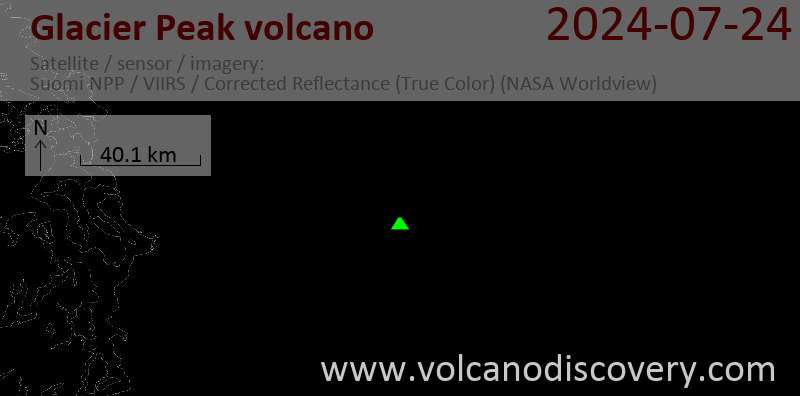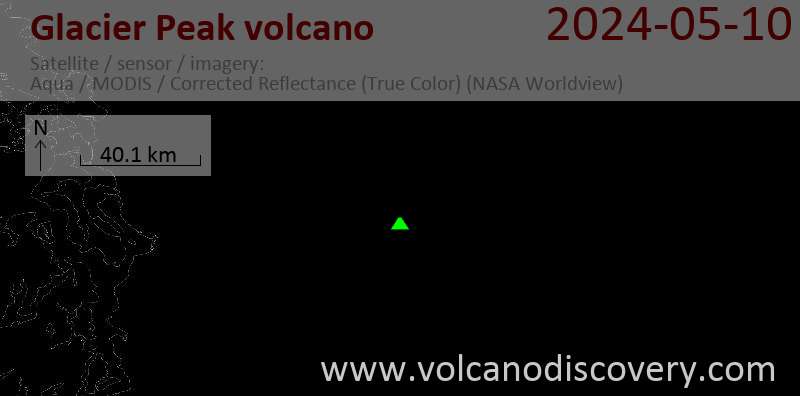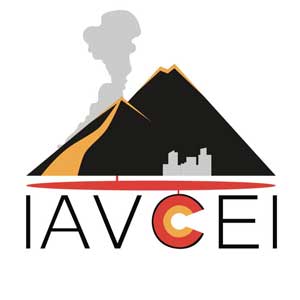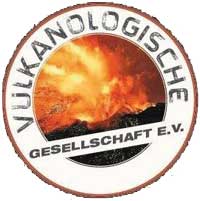Glacier Peak Volcano
Updated: Aug 27, 2025 05:14 GMT -
stratovolcano
Washington State (Canada and USA (mainland)), 48.11°N / -121.11°W 
Summit height: 3213 m / 10,541 ft
Current status: normal or dormant (1 out of 5)
Glacier Peak is a stratovolcano in northern Washington and the most remote of the Cascade volcanoes. Its name comes from the 11 glaciers on its flanks.
Although it reaches more than 10,000 feet elevation, the volcanic edifice is only 500-1000 m high, because the volcano's base is located on a high ridge.
[smaller] [larger]
Glacier Peak volcano eruptions: 1700±100, 1300±300, 900, 200 AD, 850 BC(?)
Latest nearby earthquakes
| Date and Time | Mag / Depth | Distance / Location | |||
|---|---|---|---|---|---|
Background
Glacier Peak forms a prominent peak in the rugged forested terrain of the Glacier Peak Wilderness Area in the North Cascades. Glacier Peak is a dacitic-andesitic stratovolcano with summit and flank lava domes; it resembles Mount St. Helens in its explosive vigor.Several major explosive eruptions and episodes of lava dome growth occurred in the past 10,000 years. Ash deposits from these eruptions are found over wide distances to the east. Voluminous pyroclastic flow and mudflow deposits extend into the Puget Sound lowlands to the west. Some of these deposits diverted river courses into adjacent valleys.
The latest eruption of Glacier Peak was only a few hundred years ago and was noted by Pacific Northwest Indians. Hot springs are found on its flanks.
Significant volcanic eruptions: Glacier Peak volcano
No historic eruptions are known from Glacier Peak volcano, but evidence from at least 6 eruptions during the past 10,000 years can be found in the geological record.
Additionally, there are 2 uncertain or discredited eruptions from Glacier Peak volcano.
Additionally, there are 2 uncertain or discredited eruptions from Glacier Peak volcano.
The table below lists all known eruptions (date in bold face) of Glacier Peak volcano in historic times and during the past 10,000 years. Updates on the most recent volcanic activity of Glacier Peak can be found on the news page of Glacier Peak volcano.
| Date | Note | VEI | Deaths | Damage | ||
|---|---|---|---|---|---|---|
| 2 | ||||||
?? | Uncertain Eruption | ? | ||||
| 3? | ||||||
| 4+ | ||||||
| ? | ||||||
| ? | ||||||
| ? | ||||||
Discredited Eruption | ||||||
Remark:
Our list of volcanic eruptions closely follows the database of eruptions of the Smithsonian's Global Volcanism Project (GVP), the internationally most recognized data source for volcanic eruptions, but also includes significant eruptive episodes or related volcano events. "Volcanic eruptions" are usually to be understood as sequences of individual eruptive episodes that can follow each other, or even overlap (if several vents are involved), and can last many years, decades or even longer. For example, the current activity of Stromboli volcano is understood as a single eruption that has been ongoing since 1934.
Sources: NOAA National Centers for Environmental Information (NCEI), Global Significant Volcanic Eruptions Database. doi:10.7289/V5TD9V7K | Global Volcanism Project / Smithsonian Institution
Glacier Peak Volcano FAQ
+When was the last eruption of Glacier Peak volcano?
The last confirmed eruption of Glacier Peak occurred around 1700.
+When was the largest eruption of Glacier Peak volcano?
The largest eruption known from the younger geological history of Glacier Peak volcano occurred around 200 AD. It only has a VEI (Volcanic Explosivity Index) of , likely because it was a mainly effusive eruption generating lava flows but very little ash.
Latest satellite images
Glacier Peak Volcano Maps
Below is a selection of maps showing the location and surroundings of the volcano at various resolutions based on aerial-imagery / terrain maps. Feel free to use them for non-commercial purposes on your blog or website as long as you credit them with a link back to this page (click to copy it).

Satellite/aerial-type map of Glacier Peak volcano (world scale)

Terrain-type map of Glacier Peak volcano (world scale)

Satellite/aerial-type map of Glacier Peak volcano (region scale large)

Terrain-type map of Glacier Peak volcano (region scale large)

Satellite/aerial-type map of Glacier Peak volcano (region scale medium)

Terrain-type map of Glacier Peak volcano (region scale medium)

Satellite/aerial-type map of Glacier Peak volcano (region scale small)

Terrain-type map of Glacier Peak volcano (region scale small)

Satellite/aerial-type map of Glacier Peak volcano (local scale large)

Terrain-type map of Glacier Peak volcano (local scale large)

Satellite/aerial-type map of Glacier Peak volcano (local scale medium)

Terrain-type map of Glacier Peak volcano (local scale medium)

Satellite/aerial-type map of Glacier Peak volcano (local scale small)

Terrain-type map of Glacier Peak volcano (local scale small)

Satellite/aerial-type map of Glacier Peak volcano (scale of 10s of km)

Terrain-type map of Glacier Peak volcano (scale of 10s of km)

Satellite/aerial-type map of Glacier Peak volcano (scale of 20-40 km)

Terrain-type map of Glacier Peak volcano (scale of 20-40 km)

Satellite/aerial-type map of Glacier Peak volcano (scale of approx. 10-20 km)

Terrain-type map of Glacier Peak volcano (scale of approx. 10-20 km)

Satellite/aerial-type map of Glacier Peak volcano (scale of 5-10 km)

Satellite/aerial-type map of Glacier Peak volcano (scale of few kilometers)





















